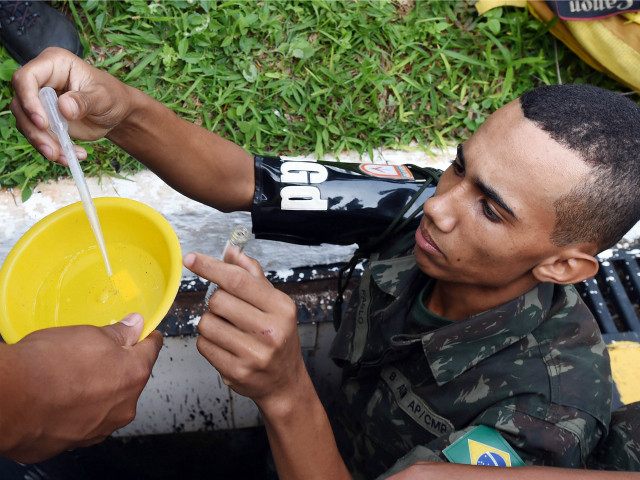With 220,000 troops on the ground and 315,000 public officials on call, the operation to eradicate the Zika virus from Brazil has become the largest military operation in that nation’s history. Many fear attempts to eradicate the mosquito-borne illness before the Summer Olympics in August will not be enough, however, as scientists study the deadly complications that accompany the disease.
Argentine news outlet Infobae describes the diversity of the skill sets of those deployed to combat the Zika virus outbreak that has affected Brazil more than any other country. Members of the Army, Marines, and Air Force have been deployed to tackle the problem door-to-door, helping eradicate mosquito nests and educating residents in the most affected areas on how to prevent still water from helping the spread of the virus.
Zika spreads through the bite of the Aedes aegypti mosquito, present in all nations of the Western Hemisphere except Chile and Canada. It is also spread through sexual transmission; Chile recently documented its first locally-transmitted case through sexual contact, leaving Canada the only nation in the hemisphere not to document a locally-acquired Zika case.
“This is a war; our enemy is very dangerous,” Fábio de Abril Luna, an official in Brazil’s Ministry of Education, said of his mission. De Abril Luna is partially responsible for an education initiative that is constantly evolving as scientists discover new dangers related to contracting Zika, new ways of contracting the virus, and new neighborhoods affected. Education officials are urging sexually active couples to use protection, pregnant women to keep their potential exposure to mosquitos at a minimum, and everyone to eliminate stagnant water pools that may form in yards and common household items after rain. This week, Brazilian officials announced that the Ministry of Education would begin offering Zika education courses in three different languages, to answer public questions about the threat.
When Brazil’s Minister of Health Marcelo Castro initially announced the mobilization of hundreds of thousands of troops in January, his message was a pessimistic one. Stating that Brazil was “badly losing the war against the mosquito,” he received criticism from the World Health Organization for making his outlook on the situation public. By the time Castro announced the military initiative, however, the U.S. National Institutes of Health had already decreed the Zika outbreak a “pandemic,” with the situation expected to get worse at the Southern Hemisphere’s summer went on.
While the Brazilian government has escalated its efforts to raise Zika awareness, the ongoing corruption scandal engulfing the ruling Workers’ Party has largely hindered those efforts. During President Dilma Rousseff’s national speech on Zika awareness in February, protesters used pots and pans to drown out televisions airing the speech as a protest against Rousseff herself. A month later, 3.4 million Brazilians took to the streets of forty different cities to demand Rousseff be impeached.
Zika infection is rarely accompanied by symptoms; only twenty percent of people affected by the virus exhibit symptoms. Symptomatic patients experience fevers, body aches, and conjunctivitis injection — symptoms often described as a milder version of Dengue fever. What Brazilian and international health officials fear is the newly-discovered link between Zika and a birth defect known as microcephaly, in which an infant is born with a skull too small for his or her head. The small skull crushes the developing brain, causing severe neurological damage. Brazil has documented more than 5,000 cases of microcephaly suspected of having been caused by Zika; tests on the victims’ mothers are largely pending.
More recently, neighboring Colombia has begun documenting an alarming increase in the number of microcephaly cases documented, believed to be linked to the growing presence of Zika there.
As the weather warms in the Northern Hemisphere, making it a more hospitable home for Aedes aegypti, health officials in the United States have begun urging regional outlets to prepare for a potential surge in the number of Zika cases. The U.S. Centers for Disease Control (CDC) hosted a “Zika Summit” Friday to address national concerns regarding the spread of Zika, in which experts stressed the need to be “ahead of the curve” on the issue. While the southern United States and Puerto Rico remain most at risk for a Zika outbreak, doctors nationwide are being told to be on alert for potential Zika cases and properly inform pregnant patients or patients who could become pregnant about the threat Zika poses to the unborn.

COMMENTS
Please let us know if you're having issues with commenting.